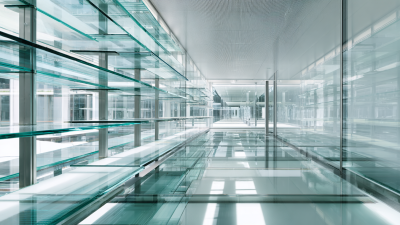
In the realm of modern architecture, the integration of innovative materials can significantly enhance both aesthetics and functionality. One such transformative material is Reflective Glass, which has gained increasing popularity due to its unique properties and versatile applications.
 This glass not only serves as a striking visual element, creating dynamic reflections and engaging interactions with surrounding environments, but also offers practical benefits such as energy efficiency and privacy.
By effectively managing solar heat gain, Reflective Glass contributes to environmentally sustainable building practices, while its reflective surface can help to mitigate urban heat island effects.
As architects and designers explore new possibilities in contemporary building design, understanding the advantages of Reflective Glass becomes essential.
This introduction aims to guide readers through the myriad benefits of incorporating Reflective Glass in their architectural projects, showcasing its potential to revolutionize modern structures while meeting the demands of energy-conscious and aesthetically driven designs.
This glass not only serves as a striking visual element, creating dynamic reflections and engaging interactions with surrounding environments, but also offers practical benefits such as energy efficiency and privacy.
By effectively managing solar heat gain, Reflective Glass contributes to environmentally sustainable building practices, while its reflective surface can help to mitigate urban heat island effects.
As architects and designers explore new possibilities in contemporary building design, understanding the advantages of Reflective Glass becomes essential.
This introduction aims to guide readers through the myriad benefits of incorporating Reflective Glass in their architectural projects, showcasing its potential to revolutionize modern structures while meeting the demands of energy-conscious and aesthetically driven designs.
Reflective glass has emerged as a significant element in modern architecture, particularly in enhancing energy efficiency and sustainability in buildings. Its unique ability to reflect sunlight reduces heat gain, thereby minimizing the reliance on air conditioning systems. This is particularly advantageous in warmer climates, where energy consumption for cooling can be substantial. By employing reflective glass, architects can create comfortable indoor environments while significantly lowering energy costs, contributing to the overall sustainability of the building.
Moreover, reflective glass plays an essential role in achieving LEED (Leadership in Energy and Environmental Design) certification and other green building standards. Its properties not only enhance thermal performance but also improve the aesthetic appeal of structures, allowing for innovative designs that harmonize with the surrounding environment. As cities increasingly turn to sustainable solutions, reflective glass will likely continue to be a cornerstone of modern architectural practices, enabling the design of energy-efficient buildings that are both functional and visually striking.
Reflective glass has become a staple in modern architecture, not only for its aesthetic appeal but also for its remarkable ability to enhance natural light while significantly reducing glare. Studies show that buildings utilizing reflective glass can increase daylight penetration by up to 30%, contributing to a more luminous and vibrant indoor environment. This natural illumination reduces the reliance on artificial lighting, leading to energy savings and a lower carbon footprint. Additionally, the reflective properties help minimize glare, which can be especially beneficial in urban landscapes where sunlight can bounce off various surfaces.
Tips for architects and designers considering reflective glass include selecting the right coating to maximize glare reduction while maintaining visibility and transparency. For instance, low-emissivity (low-E) coatings can offer a balanced solution, allowing light to enter while reflecting heat. It's also essential to assess the building's orientation and surrounding environment to optimize the benefits of natural light during different times of the day throughout the seasons.
Moreover, incorporating reflective glass can enhance occupant comfort and productivity. According to a report by the International Energy Agency, buildings with adequate daylight and minimized glare can increase worker productivity by as much as 20%. As architects embrace sustainable design practices, the use of reflective glass emerges as a critical tool in fostering healthier and more energy-efficient spaces.
| Feature | Description | Benefits |
|---|---|---|
| Light Reflection | Reflective glass reflects a significant amount of sunlight while allowing natural light inside. | Enhances natural light without compromising privacy and reduces energy costs. |
| UV Protection | Reflective glass can block up to 99% of harmful UV rays. | Protects interiors from fading and reduces health risks associated with UV exposure. |
| Glare Reduction | Minimizes glare from sunlight, enhancing comfort within the building. | Improves productivity in workspaces and creates a more pleasant environment. |
| Energy Efficiency | Aids in maintaining temperature by reducing heat gain during summer. | Lowers energy consumption for heating and cooling systems. |
| Aesthetic Appeal | Provides sleek and modern look that enhances the architectural design. | Increases property value and attracts potential buyers or tenants. |
Reflective glass has emerged as a transformative element in modern architecture, shaping not only individual buildings but also the aesthetics of urban landscapes. Its ability to reflect light creates dynamic visual effects, altering how structures interact with their surroundings. According to a report by Research and Markets, the global reflective glass market is expected to grow at a CAGR of over 8% from 2020 to 2025, highlighting its increasing popularity in urban design. The sleek appearance of reflective glass provides a contemporary appeal that complements the rising trend of sustainable building practices, aligning with the global shift towards eco-friendly materials.

Incorporating reflective glass into building designs can enhance energy efficiency, a critical factor for urban developers. For instance, reflective coatings can reduce solar heat gain by up to 60%, as noted in the International Energy Agency's report on energy-efficient buildings. This not only lowers the demand for air conditioning but also contributes to reducing the urban heat island effect, promoting a healthier city environment.
Tip: When considering reflective glass, evaluate the orientation of the building and the surrounding landscape, as these elements significantly influence the effectiveness and visual impact of the glass. Additionally, collaborating with architects who specialize in sustainable design can yield innovative solutions that maximize both aesthetics and utility.
 Reflective glass technology is at the forefront of modern architectural advancements, offering innovative solutions that enhance both aesthetics and functionality. At the recent SID 2025 exhibition, cutting-edge developments showcased how reflective glass can significantly improve energy efficiency, a crucial factor as buildings account for nearly 40% of global energy use. By utilizing advances in reflective coatings, modern architecture can now reduce heat gain, thereby lowering air conditioning costs by up to 30%, as reported by industry studies.
Reflective glass technology is at the forefront of modern architectural advancements, offering innovative solutions that enhance both aesthetics and functionality. At the recent SID 2025 exhibition, cutting-edge developments showcased how reflective glass can significantly improve energy efficiency, a crucial factor as buildings account for nearly 40% of global energy use. By utilizing advances in reflective coatings, modern architecture can now reduce heat gain, thereby lowering air conditioning costs by up to 30%, as reported by industry studies.
In addition to energy efficiency, reflective glass plays a pivotal role in urban design and smart buildings. The integration of Micro LED technology, highlighted at SID 2025, is revolutionizing how reflective surfaces can interact with light. With increased brightness and color accuracy, reflective glass can serve not only as a functional element but also as an artistic feature that transforms urban landscapes. These innovations pave the way for buildings that respond dynamically to their environment, enhancing both form and function.
Tips: When selecting reflective glass for your projects, consider the local climate and the building's orientation to optimize performance. Incorporating smart technology with reflective glass can further enhance energy savings and provide adaptive lighting solutions. Always consult with industry professionals to match the right reflective glass specifications to your architectural vision.
Reflective glass has emerged as a pivotal element in contemporary architecture, not only enhancing aesthetic qualities but also offering functional benefits. Case studies of iconic projects illustrate the successful integration of reflective glass, as seen in the Torre Agbar in Barcelona. This skyscraper employs a unique double-glazing system that incorporates reflective coatings, enhancing energy efficiency by up to 30% according to a study by the International Energy Agency. The building's striking appearance and energy conservation duality serve as a testament to the innovative use of reflective materials in modern design.
Another notable example is the One World Trade Center in New York, which utilizes reflective glass to create a stunning interplay with the skyline while minimizing solar gain. The glass facade, designed to reflect the changing colors of the sky, contributes to a reduction in energy consumption by approximately 20%, as reported by the U.S. Green Building Council. The feature not only elevates the visual impact but also aligns with sustainable practices, demonstrating the potential of reflective glass to meet both aesthetic and environmental standards in architectural endeavors.





